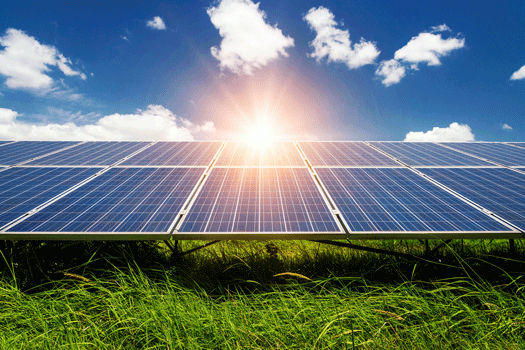We use cookies to make your experience better. To comply with the new e-Privacy directive, we need to ask for your consent to set the cookies. Learn more.
Renewable Energy in Waste Management: Solar-Powered Material Handling Equipment
When you think about renewable energy in waste management, the first thing that comes to mind is biogas. But how can material recovery facilities, haulers, and composters use green energy if they aren't producing it in an aerobic digester? Thanks to the growing affordability of solar panels, the answer could be staring us in the face every day: The sun, of course.
Solar power is booming in the United States, growing from production of just 1.2 gigawatts (GW) in 2008 to around 30 GW annually in recent years. However, few waste-management facilities have found a way to power their entire operations with the sun's energy alone.
Portable material handling equipment faces a particular challenge in adopting solar energy. Most trash can dumpers simply don't offer the surface area to support large enough solar panels. Instead of scrounging for a larger surface, however, there's another option, and it's one that's already available with Bin Dumpers from Solus Group: Build equipment to use power more efficiently.
Waste-Handling Efficiency Meets Renewable Energy Production
The Simpro Dumpmaster, for instance, is a model of energy efficiency in industrial material handling. This commercial trash can dumper can lift a 220-pound bin 10 feet in the air, empty the contents, and then set the cart gently back on the ground — all with just 18 kilojoules of energy.
Because of this efficiency, Bin Dumpers only need a 1.6-square-foot solar panel to handle more than 3 tons of materials per day. That's enough for more than 40 65-gallon bins of post-consumer glass, or more than 500 bins of recyclable plastics! (Figures based on Keep America Beautiful weight estimates for source-separated glass bottles and jars and plastic bottles.)
Green Energy: A Crucial Element of Any Sustainable Materials Management Plan
Environmental engineers look at products and processes through the lens of a life-cycle analysis. This analytical framework considers everything involved in a product's lifespan, from raw material-gathering to eventual disposal. Energy consumption is a huge part of that picture at every step of the way.
It's right in line with most commercial recyclers' missions to choose renewable energy wherever possible. Bin Dumpers with solar panels provide a simple way to start using renewable energy in waste-management operations at every stop along the sustainable materials stream.
References:
Batterman, Stuart. "Life-Cycle Assessment and Environmental Engineering." ASCELibrary. Journal of Environmental Engineering, ASCE, 1 Nov. 2004. Web. 10 Aug. 2018.
"Estimating Data." KAB. Keep America Beautiful Presents Recycle Bowl Competition, n.d. PDF 10 Aug. 2018.
"The nuclear-powered bin-tipping machine." Simpro. Simpro Handling Equipment, 9 Sept. 2016. Web. 10 Aug. 2018.
"Solar Energy in the United States." Energy. U.S. Department of Energy, Office of Energy Efficiency & Renewable Energy, n.d. Web. 10 Aug. 2018.
